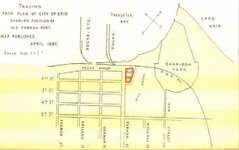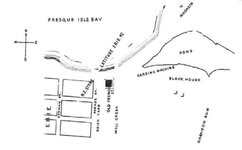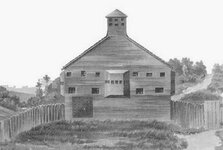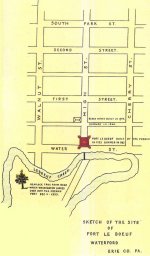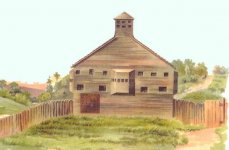Gypsy Heart
Gold Member
Among the Seaway Trail sites significant to the French and Indian War are:
• Ogdensburg, NY: Fort de La Presentation — In 1749, a fortified mission is erected by Abbe Francois Picquet extending French influence over the western nationals of the Iroquois. Plansare currently being developed to reconstruct the fort.
• Ogdensburg, NY: Chimney Island — Fort Levis, the Battle of Fort Levis 1760. During the final campaign of the French and Indian War, the French fortify Chimney Island to delay a British advance down the St. Lawrence River toward Montreal.
• Niaoure Bay: Black River Bay, Sackets Harbor, Henderson Harbor — Advanced staging area for the Marquis de Montcalmʼs attack on the British forts at Oswego in August 1756. July 5, 1756: Captain Coulon de Villiers and about 600 men establish camp here as a base for the harassment of Oswego and interception of British supplies destined for Oswego. July 27: Francois-Pierre Rigaud de Vaudrieul, brother of New Franceʼs governor, arrives with reinforcements, bringing the number of soldiers in the French camp to 1,200. August 6: Marquis de Montcalm arrives with the first division of the main French Army. By the 8th, the armyʼs second division arrives (Montcalmʼs force totaled about 3,000 men and plenty of artillery). August 9: Rigaud marches off through the woods to protect a landing site east of Oswego. The rest of Montcalmʼs force travel by bateau. After a brief siege, Oswego surrenders.
• Oswego, NY: Fort Oswego, Fort Ontario and Fort George — 1727: British fur trading post established. 1755: Fort Ontario constructed and first British battle fleet built on Great Lakes. 1756: French forces under Montcalm besiege, capture and destroy all forts. 1758: Colonel John Bradstreet uses Oswego as an advanced base to stage successful attack on French Fort Frontenac (Kingston, Ontario, Canada).1759: British reoccupy and refortify Oswego and fight off French attack protecting the rear of General Prideauxʼs expedition to capture Fort Niagara. 1760: British forces gather at Oswego to descend St. Lawrence River and capture Montreal. Today, Fort Ontario is a State Historic Site, a 19th century successor to the French and Indian War fort, interpreting military life during the 19th century. Exhibits trace the fortʼs history from the French and Indian War to World War II. Special French and Indian War event planned for August 2006.
• Fulton, NY: DeVallierʼs Raid —1756: Coulon de Villiers, the French officer who accepted George Washingtonʼs surrender at Fort Necessity two years earlier, and French raiding party attack boatmen and soldiers under John Bradstreet. The raiders inflict heavy casualties but Bradstreet successfully repels the attack.
• Sodus Bay, NY: Bay of the Cayugas —July 1, 1759: Gen. John Prideauxʼs army camps here on its way to besiege Fort Niagara.
• Rochester, NY: Irondequoit Bay —Site of French and British trading posts prior to war. 1759: Prideaux camps here on its way to besiege Fort Niagara.
• Braddockʼs Bay, NY —July 4, 1759: General Prideauxʼs army camps here on the way to Niagara.
• Lakeside, NY: Johnsonʼs Creek —July 5, 1759: General Prideauxʼs army camps here.
• Four Mile Creek, NY: Le Petit Marais —July 6, 1759: General Prideauxʼs army lands here to besiege Niagara.
• Youngstown, NY: Fort Niagara — “The Key to the Continent,” Fort Niagara was first built bythe French in 1726, and expanded 1755-57 to prepare for British attack. The Fort was beseigedin 1759 and surrendered to British. Old Fort Niagara contains original 18th century buildings;historic site interprets the fortʼs history from the French era through the Civil War.. Period rooms in the 1726 French Castle interpret solider life during the French era.
• Youngstown, NY: The Battle of La Belle Famille — July 24, 1759: some 464 British soldiers, their Iroquois allies met about 800 French soldiers and 30 native allies. British troops in a short but bloody battle stopped French efforts to relieve the besieged Fort Niagara.
• Lewiston, NY: The Lower Landing —Native Americans, and French and British soldiers left the Niagara River here to begin the difficult portage around Niagara Falls. Important French expeditions to the Ohio Valley pass this way: 1749 – Celoron, 1753 – Marin goes to Erie, PA to build Fort de la Presque Isle, 1754 – Contrecoeur builds Fort Duquesne at Pittsburgh, 1755 – Beaujeu/Dumas defeat General Braddock near Pittsburgh.
• Niagara Falls, NY: Devils Hole State Park —September 1763: a British force ambushed and defeated by Seneca warriors during Pontiacʼs War.
• Niagara Falls, NY: The Falls — The Falls of Niagara were a tourist attraction even in the 18th century. Visitors to Niagara Reservation State Park today experience much the same thrill as visitors to thisnatural wonder before and during the French and Indian War. A cruise on the Maid of the Mist and a visit to the Cave of the Winds allow visitors to experience the Falls from the perspective of those 18th century travelers who ventured to the bottom of the gorge.
• Niagara Falls, NY: The Upper Landing – 1751: French erect Fort du Portage to help divert fur trade from the English at Oswego. 1759: Fort burned and garrison withdraws to Fort Niagara. 1760: British establish a stockage above the Falls. 1763: Fort rebuilt and named Fort Schlosser. Find interpretive pedestals on Goat Island.
• Barcelona/Mayville, NY: The Chautauqua Portage – This important portage connected the waters of the Great Lakes with the Ohio River drainage, making the route extremely important in the 18th century. 1749: Captain Celoron de Blainville passes the portage in his effort to sail down the Ohio burying lead plates to reclaim the Ohio Valley drainage for France. The French continue to use this route even after they decide in 1753 that the Erie, PA, to Waterford, PA, portage will be the main route to the Ohio.
• Erie, PA – Fort de la Presque Isle, Seaway Trail Pennsylvania – 1753: Fort established to protect the new portage road to the Ohio. 1759: French muster forces to relieve the siege of Fort Niagara, burn fort. 1760: British construct Fort Presque Isle. 1763: Fort Presque Isle destroyed during Pontiacʼs War. Historic markers and monument overlooking Fortʼs original site. Nearby Erie County Historical Society contains a painting of the French fortʼs destruction as well as archaeological remains.
• Waterford, PA – Fort Sur la Riviere aux Boeufs — 1753: Washington arrives at French Headquarters to deliver demand that French evacuate Ohio Valley. 1759: French abandon and burn fort. 1760: British erect Fort Le Boeuf. 1763: British fort attacked and burned during Pontiacʼs War.
• Ogdensburg, NY: Fort de La Presentation — In 1749, a fortified mission is erected by Abbe Francois Picquet extending French influence over the western nationals of the Iroquois. Plansare currently being developed to reconstruct the fort.
• Ogdensburg, NY: Chimney Island — Fort Levis, the Battle of Fort Levis 1760. During the final campaign of the French and Indian War, the French fortify Chimney Island to delay a British advance down the St. Lawrence River toward Montreal.
• Niaoure Bay: Black River Bay, Sackets Harbor, Henderson Harbor — Advanced staging area for the Marquis de Montcalmʼs attack on the British forts at Oswego in August 1756. July 5, 1756: Captain Coulon de Villiers and about 600 men establish camp here as a base for the harassment of Oswego and interception of British supplies destined for Oswego. July 27: Francois-Pierre Rigaud de Vaudrieul, brother of New Franceʼs governor, arrives with reinforcements, bringing the number of soldiers in the French camp to 1,200. August 6: Marquis de Montcalm arrives with the first division of the main French Army. By the 8th, the armyʼs second division arrives (Montcalmʼs force totaled about 3,000 men and plenty of artillery). August 9: Rigaud marches off through the woods to protect a landing site east of Oswego. The rest of Montcalmʼs force travel by bateau. After a brief siege, Oswego surrenders.
• Oswego, NY: Fort Oswego, Fort Ontario and Fort George — 1727: British fur trading post established. 1755: Fort Ontario constructed and first British battle fleet built on Great Lakes. 1756: French forces under Montcalm besiege, capture and destroy all forts. 1758: Colonel John Bradstreet uses Oswego as an advanced base to stage successful attack on French Fort Frontenac (Kingston, Ontario, Canada).1759: British reoccupy and refortify Oswego and fight off French attack protecting the rear of General Prideauxʼs expedition to capture Fort Niagara. 1760: British forces gather at Oswego to descend St. Lawrence River and capture Montreal. Today, Fort Ontario is a State Historic Site, a 19th century successor to the French and Indian War fort, interpreting military life during the 19th century. Exhibits trace the fortʼs history from the French and Indian War to World War II. Special French and Indian War event planned for August 2006.
• Fulton, NY: DeVallierʼs Raid —1756: Coulon de Villiers, the French officer who accepted George Washingtonʼs surrender at Fort Necessity two years earlier, and French raiding party attack boatmen and soldiers under John Bradstreet. The raiders inflict heavy casualties but Bradstreet successfully repels the attack.
• Sodus Bay, NY: Bay of the Cayugas —July 1, 1759: Gen. John Prideauxʼs army camps here on its way to besiege Fort Niagara.
• Rochester, NY: Irondequoit Bay —Site of French and British trading posts prior to war. 1759: Prideaux camps here on its way to besiege Fort Niagara.
• Braddockʼs Bay, NY —July 4, 1759: General Prideauxʼs army camps here on the way to Niagara.
• Lakeside, NY: Johnsonʼs Creek —July 5, 1759: General Prideauxʼs army camps here.
• Four Mile Creek, NY: Le Petit Marais —July 6, 1759: General Prideauxʼs army lands here to besiege Niagara.
• Youngstown, NY: Fort Niagara — “The Key to the Continent,” Fort Niagara was first built bythe French in 1726, and expanded 1755-57 to prepare for British attack. The Fort was beseigedin 1759 and surrendered to British. Old Fort Niagara contains original 18th century buildings;historic site interprets the fortʼs history from the French era through the Civil War.. Period rooms in the 1726 French Castle interpret solider life during the French era.
• Youngstown, NY: The Battle of La Belle Famille — July 24, 1759: some 464 British soldiers, their Iroquois allies met about 800 French soldiers and 30 native allies. British troops in a short but bloody battle stopped French efforts to relieve the besieged Fort Niagara.
• Lewiston, NY: The Lower Landing —Native Americans, and French and British soldiers left the Niagara River here to begin the difficult portage around Niagara Falls. Important French expeditions to the Ohio Valley pass this way: 1749 – Celoron, 1753 – Marin goes to Erie, PA to build Fort de la Presque Isle, 1754 – Contrecoeur builds Fort Duquesne at Pittsburgh, 1755 – Beaujeu/Dumas defeat General Braddock near Pittsburgh.
• Niagara Falls, NY: Devils Hole State Park —September 1763: a British force ambushed and defeated by Seneca warriors during Pontiacʼs War.
• Niagara Falls, NY: The Falls — The Falls of Niagara were a tourist attraction even in the 18th century. Visitors to Niagara Reservation State Park today experience much the same thrill as visitors to thisnatural wonder before and during the French and Indian War. A cruise on the Maid of the Mist and a visit to the Cave of the Winds allow visitors to experience the Falls from the perspective of those 18th century travelers who ventured to the bottom of the gorge.
• Niagara Falls, NY: The Upper Landing – 1751: French erect Fort du Portage to help divert fur trade from the English at Oswego. 1759: Fort burned and garrison withdraws to Fort Niagara. 1760: British establish a stockage above the Falls. 1763: Fort rebuilt and named Fort Schlosser. Find interpretive pedestals on Goat Island.
• Barcelona/Mayville, NY: The Chautauqua Portage – This important portage connected the waters of the Great Lakes with the Ohio River drainage, making the route extremely important in the 18th century. 1749: Captain Celoron de Blainville passes the portage in his effort to sail down the Ohio burying lead plates to reclaim the Ohio Valley drainage for France. The French continue to use this route even after they decide in 1753 that the Erie, PA, to Waterford, PA, portage will be the main route to the Ohio.
• Erie, PA – Fort de la Presque Isle, Seaway Trail Pennsylvania – 1753: Fort established to protect the new portage road to the Ohio. 1759: French muster forces to relieve the siege of Fort Niagara, burn fort. 1760: British construct Fort Presque Isle. 1763: Fort Presque Isle destroyed during Pontiacʼs War. Historic markers and monument overlooking Fortʼs original site. Nearby Erie County Historical Society contains a painting of the French fortʼs destruction as well as archaeological remains.
• Waterford, PA – Fort Sur la Riviere aux Boeufs — 1753: Washington arrives at French Headquarters to deliver demand that French evacuate Ohio Valley. 1759: French abandon and burn fort. 1760: British erect Fort Le Boeuf. 1763: British fort attacked and burned during Pontiacʼs War.
Amazon Forum Fav 👍
Upvote
0



